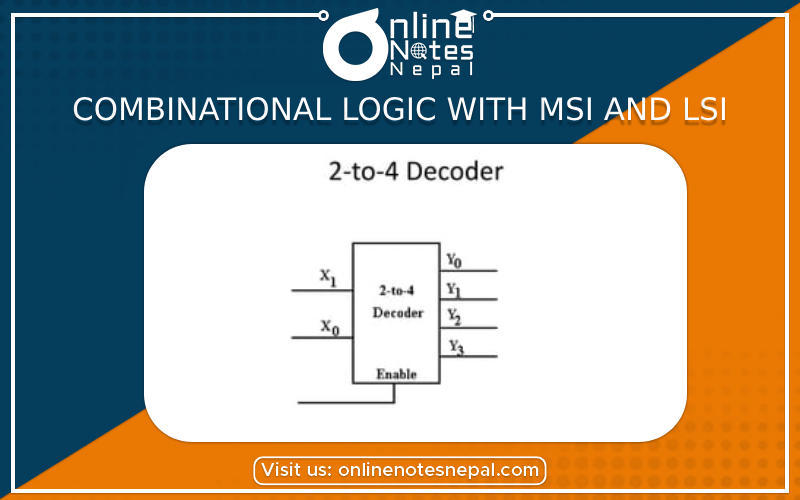Published by: Dikshya
Published date: 10 Jul 2023

A combinational circuit is a type of digital logic circuit where the output is solely determined by the current input values, without any memory or feedback. The output of a combinational circuit is determined by applying a specific logic function to the input variables. Combinational circuits are built using basic logic gates such as AND, OR, NOT gates, and can be implemented using various types of electronic components or integrated circuits.
Characteristics of Combinational Circuit:
1. Input Variables: Combinational circuits have one or more input variables, which represent the information or data to be processed by the circuit. These input variables can have binary values (0 or 1) or multiple states, depending on the specific circuit design.
2. Logic Functions: Combinational circuits apply logic functions to the input variables to generate the output values. The logic functions are defined by the specific arrangement and interconnections of the basic logic gates within the circuit.
3. Output Generation: The output values of a combinational circuit are generated directly from the input values and the applied logic functions. There is no memory or feedback mechanism in combinational circuits, meaning that the output is solely dependent on the current input values.
4. Timing: Combinational circuits operate in real-time, meaning that the output is generated immediately after applying the logic functions to the input values. There are no internal clocks or sequential elements in combinational circuits, and the output is available as soon as the inputs are stable.
Examples of combinational circuits include adders, subtractors, multiplexers, demultiplexers, encoders, decoders, and comparators. These circuits perform specific operations or transformations on the input data based on the logic functions implemented within them.
MSI (Medium-Scale Integration):
- MSI devices are integrated circuits that contain a moderate number of gates and components on a single chip.
- They provide a higher level of integration compared to basic logic gates, allowing for more complex combinational logic functions to be implemented in a single chip.
- Common examples of MSI devices include multiplexers, demultiplexers, encoders, decoders, adders, and comparators.
- These devices typically offer a fixed set of functions and configurations, providing convenient building blocks for combinational logic designs.
LSI (Large-Scale Integration):
- LSI devices are integrated circuits that contain a large number of gates and components on a single chip.
- They provide even higher levels of integration compared to MSI devices, enabling more complex and customized combinational logic functions.
- LSI devices are often programmable or configurable, allowing designers to define the desired combinational logic functions by configuring the internal connections or programming the device.
- Field-Programmable Gate Arrays (FPGAs) are examples of LSI devices widely used for implementing complex combinational logic designs.
Combinational logic circuits are built using basic logic gates (such as AND, OR, NOT gates) and can be implemented using different types of integrated circuits, including MSI (Medium-Scale Integration) and LSI (Large-Scale Integration) devices.
1. Functional Blocks: MSI and LSI devices often consist of pre-designed functional blocks or standard building blocks, such as adders, decoders, encoders, multiplexers, and comparators. These blocks can be interconnected to implement more complex functions.
2. Circuit Flexibility: MSI and LSI devices provide a high level of flexibility in designing complex combinatorial logic circuits. Designers can select and connect the appropriate functional blocks based on the desired logic functions.
3.Component Reduction: By using MSI and LSI devices, designers can significantly reduce the number of individual components (such as discrete logic gates) required to implement complex combinatorial logic circuits. This leads to space savings, improved reliability, and simplified circuit board layouts.
4.Design Efficiency: MSI and LSI devices offer efficient design options due to their compact size and integration of multiple logic functions. This simplifies the design process and reduces the chances of errors during circuit implementation.
5. Performance Considerations: When using MSI and LSI devices, designers need to consider performance factors such as propagation delay, power consumption, fan-out capabilities, and noise immunity. These parameters can impact the overall performance of the combinatorial logic circuit.
6.Design Reusability: MSI and LSI devices provide a reusable design approach. Once a specific functional block or integrated circuit is designed and tested, it can be easily replicated or reused in different combinatorial logic circuits, saving time and effort in future designs.
7.Integration Challenges: As the complexity and scale of integration increase, designers may face challenges related to power distribution, thermal management, signal integrity, and testing. Proper design techniques and methodologies need to be employed to address these challenges effectively.
Overall, utilizing MSI and LSI devices in combinatorial logic design enables the implementation of complex functions with reduced component count, improved efficiency, and increased design flexibility.